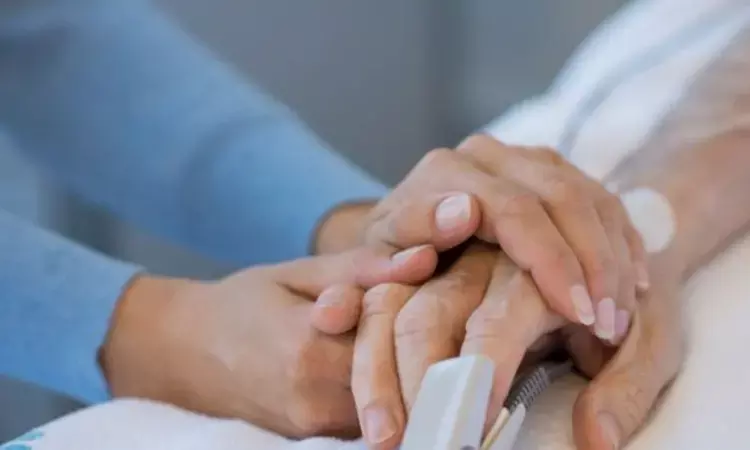- Home
- Medical news & Guidelines
- Anesthesiology
- Cardiology and CTVS
- Critical Care
- Dentistry
- Dermatology
- Diabetes and Endocrinology
- ENT
- Gastroenterology
- Medicine
- Nephrology
- Neurology
- Obstretics-Gynaecology
- Oncology
- Ophthalmology
- Orthopaedics
- Pediatrics-Neonatology
- Psychiatry
- Pulmonology
- Radiology
- Surgery
- Urology
- Laboratory Medicine
- Diet
- Nursing
- Paramedical
- Physiotherapy
- Health news
- Fact Check
- Bone Health Fact Check
- Brain Health Fact Check
- Cancer Related Fact Check
- Child Care Fact Check
- Dental and oral health fact check
- Diabetes and metabolic health fact check
- Diet and Nutrition Fact Check
- Eye and ENT Care Fact Check
- Fitness fact check
- Gut health fact check
- Heart health fact check
- Kidney health fact check
- Medical education fact check
- Men's health fact check
- Respiratory fact check
- Skin and hair care fact check
- Vaccine and Immunization fact check
- Women's health fact check
- AYUSH
- State News
- Andaman and Nicobar Islands
- Andhra Pradesh
- Arunachal Pradesh
- Assam
- Bihar
- Chandigarh
- Chattisgarh
- Dadra and Nagar Haveli
- Daman and Diu
- Delhi
- Goa
- Gujarat
- Haryana
- Himachal Pradesh
- Jammu & Kashmir
- Jharkhand
- Karnataka
- Kerala
- Ladakh
- Lakshadweep
- Madhya Pradesh
- Maharashtra
- Manipur
- Meghalaya
- Mizoram
- Nagaland
- Odisha
- Puducherry
- Punjab
- Rajasthan
- Sikkim
- Tamil Nadu
- Telangana
- Tripura
- Uttar Pradesh
- Uttrakhand
- West Bengal
- Medical Education
- Industry
Remote physician and In-home physician visits equally good for care of adverse events: JAMA

Cancer in Kerala
A new study conducted by David M. Levine and colleagues showed that remote physician visits were not worse than in-home physician visits when providing home hospital care for adverse events and patient experience. The findings of this study were published in the Journal of American Medical Association.
Home hospital care is the replacement of inpatient acute care services that are typically provided in a hospital setting. Scalability may be hampered by the requirement that doctors visit patients at home daily in many home hospital models. It is uncertain if virtual doctor appointments can effectively replace most in-person visits. This study was conducted in order to compare remote and in-home medical treatment.
Inpatient acute care services, which are normally offered in a hospital setting, are replaced by home hospital care. The necessity that doctors visit patients at home every day in many home hospital models may limit scalability. It's debatable if virtual medical visits can successfully take the place of the majority of in-person visits. This study was carried out to compare medical care provided remotely versus in-home. For the purposes of this research, all patients received acute treatment at home, including point-of-care tests, in-home nurse or paramedic visits, IV medicines, and remote monitoring.
The key findings of this study were:
1. 172 participants in all were randomized; enrollment was cut short because to COVID-19.
2. 42 (24.4%) patients lived alone, 97 patients (56.4%) were female, 77 (45.0%) were White, and the mean (SD) age was 69.3 (18.0) years.
3. The difference of 2.8 between the mean adjusted adverse event count for patients receiving remote care and control patients—6.8 per 100 patients vs. 3.9 per 100 patients—supports noninferiority.
4. The mean adjusted Picker Patient Experience Questionnaire 15 score difference between remote care patients and control patients was 0.22, demonstrating noninferiority.
5. The difference in the mean absolute 30-day readmission rate was 2.28%, which was not statistically significant. 16 (19.0%) of the patients in the distant group needed further home visits after the initial visit.
In conclusion, although the ability to conduct in-home physician visits when necessary was crucial for the remote physician group, no system of remote physician care can be relied upon in isolation, remote physician care was generally acceptable and statistically non-inferior to in-home physician care for patient safety and patient experience.
Reference:
Levine, D. M., Paz, M., Burke, K., Beaumont, R., Boxer, R. B., Morris, C. A., Britton, K. A., Orav, E. J., & Schnipper, J. L. (2022). Remote vs In-home Physician Visits for Hospital-Level Care at Home. In JAMA Network Open (Vol. 5, Issue 8, p. e2229067). American Medical Association (AMA). https://doi.org/10.1001/jamanetworkopen.2022.29067
Neuroscience Masters graduate
Jacinthlyn Sylvia, a Neuroscience Master's graduate from Chennai has worked extensively in deciphering the neurobiology of cognition and motor control in aging. She also has spread-out exposure to Neurosurgery from her Bachelor’s. She is currently involved in active Neuro-Oncology research. She is an upcoming neuroscientist with a fiery passion for writing. Her news cover at Medical Dialogues feature recent discoveries and updates from the healthcare and biomedical research fields. She can be reached at editorial@medicaldialogues.in
Dr Kamal Kant Kohli-MBBS, DTCD- a chest specialist with more than 30 years of practice and a flair for writing clinical articles, Dr Kamal Kant Kohli joined Medical Dialogues as a Chief Editor of Medical News. Besides writing articles, as an editor, he proofreads and verifies all the medical content published on Medical Dialogues including those coming from journals, studies,medical conferences,guidelines etc. Email: drkohli@medicaldialogues.in. Contact no. 011-43720751


